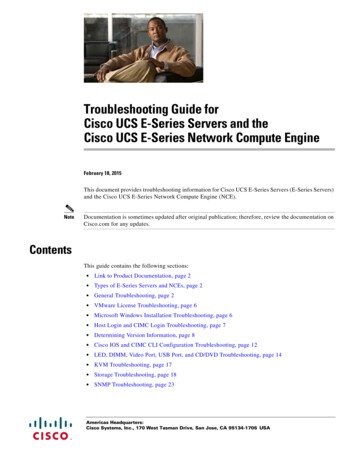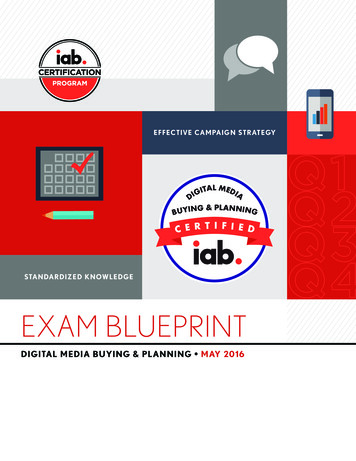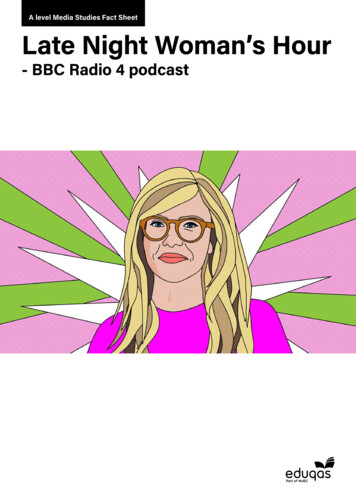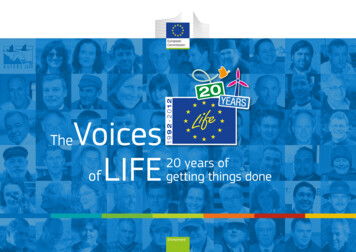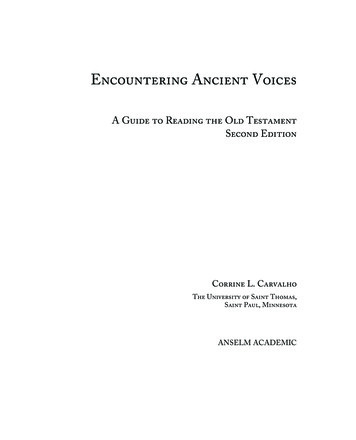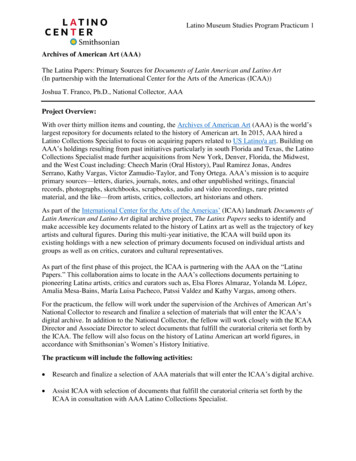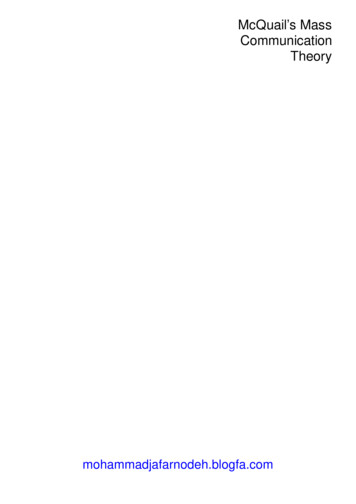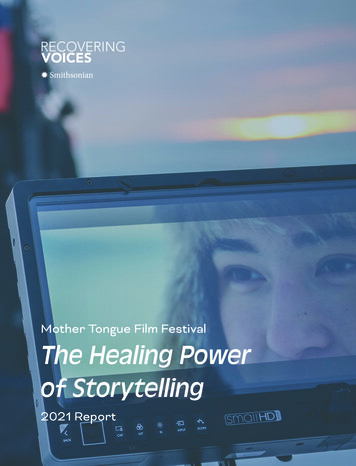
Transcription
RECOVERINGVOICESMother Tongue Film FestivalThe Healing Powerof Storytelling2021 Report
Mother Tongue Film FestivalThe Healing Power of Storytelling2021 Report
Table of ContentsThe Healing Power of Storytelling — Directors’ Remarks32021—Year in Review 6Schedule of Events 7Transition to Online Programming10Attendance 13Social Media Growth 14Evaluation 1612On Cover:Ada Blackjack RisingPartners 21dir. Brice Habeger (2020)Languages: Iñupiaq, EnglishRegion: AlaskaAppendices 25Kapaemahudir. Hinaleimoana Wong-Kalu (2019)Language: Ōlelo Ni‘ihau HawaiianRegion: Hawai‘iAppendix 1: Languages and Regions25Appendix 2: Staff 26Appendix 3: Press Coverage27
The Healing Powerof StorytellingDirectors’ RemarksThis year’s Mother Tongue Film Festival was a year of firsts—working remotely as a team between Denmark, California, Hawai‘i, Indiana, Maryland,Massachusetts, and Washington, D.C.; hosting a virtual festival; and enduring a pandemic with our families, friends, and colleagues. Through a rangeof beautiful films and dialogues with their directors across mountains,oceans, languages, and screens, the festival offered respite from a trying year. While we faced unique challenges bringing the festival online, ourcuratorial team, production staff, and interns are a fantastic collection ofdedicated people. None of what occurred could have happened withoutthem. We have learned an immense amount over the past year and aregrateful to all the filmmakers, our partners, and colleagues who helpedmake this year’s Mother Tongue Film Festival the success that it was.13The festival covered a range of topics as vast as the geographic regionsand languages represented (twenty-six and thirty-nine, respectively). AsSmithsonian Secretary Lonnie Bunch remarked in our virtual opening,this year’s festival “examined.language revitalization, the power of womensharing their stories, and the extensive repository of films in the Smithsonian archives.” Our theme—chosen in reference to the global pandemic—alludes to the power of film and digital storytelling to address and begin torepair the continued violence of settler colonialism worldwide, while alsoemphasizing the need to listen to Indigenous and Native stories in theirvaried forms. Gwyneira Isaac, Director of Recovering Voices and Curatorof North American Indigenous Culture at the National Museum of Natural History, describes our mission well: “This festival celebrates peoples’rights to speak their mother tongue. By making these films, people voicetheir individual experiences, and, more importantly, define themselves using their own language.” Mother Tongue is a celebration and a call to actionthat highlights the beauty within multilingual storytelling.Joshua A. BellAmalia I. CórdovaMy Name is Mudjudir. Chantelle Murray (2019)Languages: Yugarabul, EnglishRegion: Australia24
2021Year in ReviewIn 2021, the Mother Tongue Film Festival saw change, expansion, and opportunity in its sixth annual edition. In response to the COVID-19 pandemic, the festival pivoted to a fully online experience centered around thetheme of The Healing Power of Storytelling.The festival is a collaborative effort from across the Smithsonian Institution organized by the Recovering Voices initiative, a collaboration betweenthe National Museum of Natural History (NMNH), the Center for Folklifeand Cultural Heritage (CFCH), the National Museum of the American Indian (NMAI), and the Asian Pacific American Center (APAC). Celebratingcultural diversity, Mother Tongue puts language center stage to reveal therichness and healing power that exists within multilingual storytelling andexpression.5The Moutaindir. Su Hung-En (2015)Languages: Mandarin, TrukuRegion: TaiwanOpening on International Mother Language Day, February 21, the 2021festival expanded beyond our four-day format to a hundred-day eventrunning through the end of May. Over three months, we presented forty-five films featuring thirty-nine languages from twenty-six regions of theworld. In addition to the on-demand online film screenings, the festival alsotreated its audience to fourteen online events; among them was an opening ceremony with remarks from Smithsonian Secretary Lonnie Bunch,live and pre-recorded Q&A sessions with film directors, and engagingroundtable discussions with live audience participation.While we missed the energy of in-person events, being virtual allowed thefestival to reach new and diverse audiences. As the festival progressed,we received overwhelmingly positive feedback on the online format. It hasbeen a year of challenges, but despite this, we have learned new ways ofconnecting. Moving forward, in 2022 we will be resuming in-person eventswhile also having online offerings. This hybrid model will combine the bestaspects of in-person offerings while allowing us to virtually reach communities across the country and world.We thank you for a year of new challenges and growth and for your continued support of the Mother Tongue Film Festival.6
Schedule of EventsFebruary 21, 6 pmOpening Ceremony: The HealingPower of Storytelling Conversation with the Filmmakers:Waikiki, co-presented by theHawai‘i International Film Festival8 pmConversation with the Filmmaker:Teko Haxy/Being Imperfect7March 5, 12 pmConversation with the Filmmaker:Kiraiñia, co-presented by theUniversity of Maryland Center forResearch and Collaboration in theIndigenous Americas2 pmWomen Directors PanelFebruary 25, 6:30 pmDocumentary FilmmakerDiscussion: Tote/Grandfather,co-presented by the ColumbiaUniversity School of the ArtsMarch 1, 3 pmConversation with theFilmmaker: KapaemahuMarch 19, 2 pmArchival Roundtable:Anthropologists as Storytellers,co-presented by DocumentaryEducational Resources100 Days25x the length of previous festivals!March 26, 9 amConversation with the Filmmaker:The Mountain, co-presented by theMinistry of Culture, Taiwan; TaiwanAcademy and the National Museumof Asian ArtApril 26, 12 pmConversation with the Filmmakers:The Forbidden Strings, co-presented by the National Museum ofAsian ArtApril 2, 1 pmRoundtable: A Discussion onLanguage RevitalizationApril 30, 12 pmConversation with theFilmmaker: Haka Puai te Kainga/Eating Up Easter8May 7, 12 pmConversation with theFilmmaker: The Land of EbMay 14, 5 pmThe Healing Power ofStorytelling RoundtableMay 21, 4 pmConversation with theFilmmakers: Island to Island39 Languages45 FilmsIncluding an Indigenous animation playlist!See a comprehensive list on page 25!26 RegionsSee these listed on page 25 too!
Transition toOnline ProgrammingPivoting to an entirely virtual experience, the bilingual (English/Spanish)Mother Tongue website became a virtual screening room and “festivalhub” where audiences could access information, films, and events.The decision to host directly from the Mother Tongue website allowed thefestival to present each film while abiding by the streaming parameters ofeach filmmaker. Thanks to external partnerships, we were able to screenfilms that could not be hosted on the Mother Tongue website. An exampleof this was the Opening Night film, Waikiki, a continental premiere that wereprised in May, thanks to a partnership with the Hawai‘i International FilmFestival. In consultation with the filmmakers, most films were cohesivelypresented on the website and were accessible from two days to the entirerun of the festival. We are grateful to our many partners for helping ushost the festival through their various platforms.19The festival opened with ten films available on the website and a playlist,Animating the Mother Tongue, consiting of twelve animated short films andcross-posted on Folklife Magazine. The festival created a welcome video alongside a promotional reel which featured Smithsonian SecretaryLonnie Bunch and Mother Tongue co-directors Joshua Bell and AmaliaCórdova, festival curators Mary Linn and Kālewa Correa (Kānaka Maoli)and Recovering Voices director Gwyneira Isaac. The festival opened witha recorded conversation between Correa and Christopher Kahunahana(Kānaka Maoli), director of Waikiki, with producer Nicole Naone (Kānaka Maoli) and actor Danielle Zalopany (Kānaka Maoli). In conjunction withthese films, the festival hosted two Q&A discussions with the filmmakers.Córdova discussed the film Teko Haxy/Being Imperfect with the co-director, Sophia Pinhiero, joining from Rio de Janeiro, Brazil. Later that week,we collaborated with the Columbia University School of the Arts to present a conversation with María Sojob (Tsotzil), director of Tote/Grandfather, with Córdova and award-winning filmmaker Sebastían Díaz.During March, the festival honored Women’s History Month with powerfulfilms and events highlighting the role of women as transmitters of distinctcultures. Fifteen new films were made available for the month, includingA collage of screenshots from a selection ofMother Tongue 2021 live-streamed events.10
Hinekura, a short film directed by Becs Arahanga (Kai Tahu, Ngati Raukawa) that follows the journey of a young Māori woman. March also broughtback our Women’s Director Roundtable, featuring Arahanga, ValeriyaGolovina (director of Mawhialeo Ote Alowha/Our Love), and co-directorsof the film Teko Haxy/Being Imperfect Sophia Pinhiero and Patrícia Ferreira (Mbaya-Guaraní), moderated by filmmaker and curator Cass Gardiner (Anishinaabe Algonquin), with Córdova. We thank the SmithsonianAmerican Women’s History Initiative for supporting this event and thescreening of these films.11In conjunction with Documentary Educational Resources (DER), the festival presented the Archival Roundtable: Anthropologists as Storytellers,which centered on the collaborative work of anthropologists and filmmakers Lina Fruzzetti and Ákos Östör, whose films have recently been archived in the Smithsonian Human Studies Film Archives. This live sessionwas moderated by DER director Alice Apley, involved Pam Wintle, SeniorFilm Archivist, and was introduced by Joshua Bell. The festival screenedtheir six films, which are distributed by DER, for the month. The Marchonline events concluded with a live Q&A with Su Hung-En, director of TheMountain, translated by Betty Chen, moderated by National Museum ofAsian Art film curator Tom Vick, and introduced by Bell. This event waspresented in conjunction with the Taiwan Academy, the Taiwan Ministry ofCulture, and the Freer Gallery of Art and the Arthur M. Sackler Gallery—the Smithsonian’s National Museum of Asian Art.In April we featured six new films on the Mother Tongue website and heldthree special events. We opened the month’s programs with the live education roundtable A Discussion on Language Revitalization, focusing onlanguage efforts in Indigenous communities across the globe. In conversation with Ruben Reyes (Garifuna) on his film Garifuna in Peril, Kari Chew(Chickasaw) of Growing the Fire Within, and Putu Desy Apriliani, who discussed her involvement with BASAbali and the animation Luh Ayu ManikMas, the event was introduced and moderated by Mary Linn. April’s offerings also included two Q&As: a live discussion about the feature filmThe Forbidden Strings, with director Hasan Noori and producer AfsanehSalari, moderated by Vick and introduced by the project manager, AnnePedersen. This event was presented in conjunction with the Freer Gallery of Art and the Arthur M. Sackler Gallery—the Smithsonian’s NationalMuseum of Asian Art. April’s third event honored Earth Day with a discussion on the environmental impacts of tourism and development on RapaNui (Easter Island). Kālewa Correa introduced and led the conversationwith Sergio M. Rapu (Rapa Nui), director of Haka Puai te Kainga/EatingUp Easter.The final month of the Mother Tongue Film Festival closed with six newfilms and three events. Celebrating Asian Pacific American HeritageMonth, the festival screened films that shared Pacific cultural narratives,including The Land of Eb, Island to Island, Kapaemahu, and a second run ofWaikiki. The first of the May events was a recorded Q&A with the directorof The Land of Eb, Andrew Williamson, and lead actor Jonithen Jackson,with translation by Tarji Johnitan, moderated by Joshua Bell. Centering onthe festival’s theme, The Healing Power of Storytelling roundtable discussion followed, bringing together Christopher Auchter (Haida), director ofMountain of SGaana; Adrian Baker (Hopi), the director of Source of theWound; Christopher Kahunahana (Kanaka Maoli), director of Waikiki; andHinaleimoana Wong-Kalu (Kānaka Maoli), the director of Kapaemahu inconversation with Correa. The final event was a Q&A session with Jacqueline Hazen, director of Island to Island, and the lead actors in her film,Kris Kato and Keoni DeFranco (Kānaka Maoli), moderated by Bell. We aregrateful to the New Zealand and Canadian embassies and the Smithsonian Asian Pacific American Initiatives Pool for supporting these events.To mark the end of the festival, the curatorial team, staff, and interns recorded a closing message video to thank our partners, the filmmakers,funders, and viewers. All roundtables, Q&A sessions, and videos are posted and close-captioned for free viewing at the festival’s YouTube page,Mother Tongue Media.The festival’s move to online programming relied on the expertise of theSmithsonian Folklife Festival’s production staff, and on the CFCH cultural sustainability team’s project management and communications staff,generously supported by Ferring Pharmaceuticals. With the FolklifeFestival’s transition to online programming in 2020, we greatly benefitedfrom the team’s knowledge and experience. We are grateful to SabrinaMotley, Elisa Hough, Sarah Roffman, Diane Nutting, Jason Morris, AlexTaggert, Anne Pedersen, Cecelia Halle, and intern Katelyn Haas, whosecareful guidance and support allowed us to produce and make accessiblehigh-quality virtual events.This support builds on the long-term support of The Elizabeth and Whitney MacMillan Endowment, which helped create Recovering Voices atNMNH, and the ongoing federal and trust funds which support curatorsand other infrastructures at the Smithsonian.12
AttendanceSocial Media GrowthOver its hundred days, the festival hosted fourteen multillingual onlineevents across virtual platforms, ranging from public Facebook and YouTube live streams to Zoom events requiring registration. The extendedduration of the festival, paired with our transition to an entirely virtualprogram, allowed us to expand our audience like never before, resulting in7,888 views of our events and 6,137 views of the films.While the festival’s social media growth has usually intensified in February, the expanded timeline in 2021 allowed for an extended period of social media interaction. Hosted on the Recovering Voices Facebook andTwitter accounts, Mother Tongue’s social media impact blossomed overour 100 days online. In this timeframe, Mother Tongue’s Twitter presencefeatured 122 tweets, 81 mentions,1 201 new followers, 19,407 profile visits,2and 212,091 impressions.3 On Facebook, our presence featured 91 posts,352 new page likes, 3,870 post-engaged users,4 and a total post reach of76,934.5 Given that the increased engagement of Mother Tongue on socialmedia garnered such excellent numbers, it will be worthwhile to increaseMother Tongue’s social media presence in the off-season to continue engaging with our audiences.Our audience expanded in part thanks to the increase in festival presscoverage, with mentions in the Washington City Paper, Washingtonian,Smithsonian Magazine, WAMU, and, for the first time, the New York Times(the Language Revitalization Roundtable was listed as a “thing to do” theweek of March 27 in the “At Home” section). Unsurprisingly, the roundtable was our best-attended event, with 1,253 views across Facebook andYouTube.13Of the fourteen events, six were produced live with American Sign Language interpretation and real-time captioning (CART). While providingcomprehensive accessibility services for our programming is still a relatively new venture for the festival, the Mother Tongue team is committedto continuing to provide these services for our audience. Though attendance for our accessibility simulcast was relatively low, the audience members in attendance highlighted the importance of providing these services,which we will continue to expand in the future.In addition to the growth on Facebook and Twitter, the festival also expanded its reach in new ways: through a YouTube account, email resourceaccount, and newsletter. Between January and June 2021, our YouTubeaudience grew to 163 subscribers and garnered 5,510 views of our content. Indeed, while the YouTube account provided a new entry point foraudience members and participants to experience festival programming,our email resource account and newsletter worked to consolidate communications between the Mother Tongue team, participants, audiencemembers, and the general public.While previous festivals have involved the production of various articles,this year the Mother Tongue team made a concerted effort to write morearticles about the festival. In total, five articles were written by internsMaya Sanchez, Mariel Tabachnick, and Maddie Van Oostenburg (see appendix 4). These pieces helped to contextualize the festival, the films shownthis year, and our theme. They also gave our interns room to explore thecontent and their own interests. These articles collectively helped promote the festival and marked a new phase in the event’s development.1 A mention is a Tweet that contains another person’s username anywhere in the body of the tweet.2 Profile visits refers to the number of times users visited your profile page after viewing a tweet.3 Impressions refers to the number of times users are served a tweet in timeline or search results.4 Post-engaged users refers to the number of unique users who had any content from ot about your page enter theirscreen. This includes posts, check-ins, ads, social information from people who interact with your page. and more.5 Post reach refers to the number of users who saw specific posts from your page.Screenshot of the ASL-interpreted simulcast of the eventArchival Rountable: Anthropologists as Storytellers.14
EvaluationThe Mother Tongue Film Festival operates with three main outcomes, andfor the first time we conducted both a participant and an audience survey(English and Spanish) to help us understand the impact of our work. Thefollowing are findings from a review of the festival program, the surveys,and communication with participants and audiences during planning andexecution.Festival Outcome 1: Acknowledge marginalized peoples’ experiencesFirst and foremost, the festival works to highlight underrepresented language communities. As languages cannot detach from daily life experiences, the festival seeks to highlight some of the specific challenges and joysthat language communities face, seen through “new” lenses.15Seed and Earthdir. Lina Fruzzetti, Alfred GuzzettiNed Johnston, and Ákos ÖstörLanguage: BengaliRegion: IndiaMany of our 2021 selections deal with the experience of being away fromone’s ancestral lands, an often painful experience shared by many marginalized communities. This was explored in both The Land of Eb, a film abouta Marshallese family living in Hawai‘i after being displaced by nuclear testing from the Marshall Islands, and in The Forbidden Strings, where members of an Afghan rock band living in Iran risk everything to play a concertin the land of their ancestors. Empowerment is also the theme in Luh AyuManik Mas where a young Balinese girl channels powerful energies withinherself to prevent an environmental catastrophe. Also addressing the environment and a looming catastrophe from excessive tourism is the documentary Haka Puai Te Kainga/Eating Up Easter. These are just to mentiona few; there are many other themes acknowledging the experiences ofmarginalized communities explored in this year’s Mother Tongue films.The festival’s success in acknowledging diverse or marginalized communities is also found in several comments from participants and audiences:“In some ways, having the festival available online without a chargemade it even more accessible particularly for those in local languagecommunities who often feel like they are working in isolation. The festival raised the global efforts to say that mother tongues really do matter, for the local language communities and for everyone else as well.”16
“It’s an honor to be included in the Mother Tongue Film Festival. Thefestival is a truly meaningful way to promote language diversity andrevitalization and we love this year’s theme of The Healing Power ofStorytelling. We appreciate you continuing the festival digitally duringthe pandemic.”“The films that I watched were outstanding, and it was wonderful to beable to access them from home on a flexible schedule.”“With no doubt, this participation in the Mother Tongue Film Festivalwill make a deep and positive imprint in the Cubeo community’s commitment to existence.”“Seguir con este festival, es una ventana para conocer el mundo, susculturas, sus lenguas, su cosmovisión. Estos espacios de encuentro,diálogo y aprendizaje con otros hermanos del mundo, son enriquecedores.” [“Continuing with this festival is a window to get to know theworld, its cultures, its languages, its worldviews. These spaces formeeting, dialogue and learning with other brothers around the worldare enriching.”]“I really appreciate the emphasis and clarity with which you tell people that mother tongues are valuable. I grew up with people aroundme shunning my language and calling it broken and disrespecting myKreyol, so seeing a festival like this means a lot to me and learningabout the beauty of other people’s languages and heritage is wonderful. I can’t tell you how grateful I am for this event.”Festival Outcome 2: Strengthen interconnectivity and information flowamong Indigenous media organizations, producers, and their audiences.17A challenge for the 2021 festival was creating a feeling of closeness andconnection, despite not meeting in person. We take pride in bringing filmmakers together in conversation, so we wanted to continue that workwhile knowing that a virtual context would create a different feeling of togetherness. Due to the very nature of our virtual programming, which expanded our reach beyond the physical location of Washington, D.C., andthose who could travel there, participants and audience members felt thatit was a vital opportunity to engage more broadly with remote communitiesthan before.Some comments from the participants and audiences:“I loved that there was online content available because often as Istarted watching, friends or family who would really appreciate or enjoy the content came to mind and I could easily send them the link evenafter the live event had finished. It was so easy to share things that Ihad seen and enjoyed, something that would not have been possiblewith just in-person. A huge positive over past Mother Tongue Film Festivals!”“I am so grateful to have had access to seeing these. I live in a smalltown so it is not easy to have an opportunity to see films not widelydistributed.”“The opportunity to meet other Indigenous language activists” [a participant answering what the best thing about the festival is].The transition to online programming brought many opportunities to create new spaces for rich conversations across geographic distances. Participants reported experiencing increased awareness about their workthrough higher website traffic, invitations to participate in other events,and inquiries about their work and how to support it, for example. Thefestival saw a significant increase in interest from filmmakers wishing toscreen their work, resulting in thirteen films waiting to be reviewed by ourcuratorial team for next year. We also received an increase in inquiriesabout corporate sponsorship and private and foundation donations, all attesting to an increased awareness of our important work.Festival Outcome 3: Increase awareness and understanding of Indigenous and minoritized perspectives for majority language speakers toembrace unique voices and worldviews and create a healthy multilingualworld.Transitioning online allowed us to reach audiences in a total of 140 countries, albeit with almost seventy percent being from the United States andthe majority of those based on the East Coast. With a relatively low response rate on the audience surveys, the feedback may not give an accurate or complete view of the experiences with the festival, but the vastmajority of respondents reported that they learned new and/or diverseperspectives on the world’s many different communities. Ninety-sevenpercent of the respondents also said that the experiences made themappreciate diverse perspectives and languages more.This is also apparent in the comments about what they liked most aboutthe festival:18
“Thank you so much for all your hard work. My mind is blown by several of the gripping stories/movies and the specifics of each situation. Iknow I am learning a lot!”“I love storytelling and I appreciate the fact that people in the films aretelling their own stories. The festival is authentic and well put together.The films have taught me so much and I would have never learned anyof these things otherwise, so I’m grateful for the knowledge I was given access to through this festival and I really hope you keep offeringthe virtual format as well as in person options. I am an undergraduatestudent and I have shared this link in almost all my courses and with somany of my professors because of how much I enjoyed this, so thankyou so much. Please keep doing this.”“Having this amazing opportunity to hear first-hand accounts of thegreat diversity within Indigenous cultures from all parts of the globe”“This was one of the best organized online film festivals I saw this year”19A valuable part of our evaluation efforts was to hear constructive feedback on the curation, format, and website design points that we will carrywith us as we consider our hybrid model for 2022. Some suggestions wereceived were:Create an overview of a full schedule or downloadable calendar withfilm availability and registration information (if applicable).Avoid registration completely.Make films available for the entirety of the festival or at least for longer—many viewers missed the films that were screened for only a fewdays.Create a playlist function to enable binge-watching.Maintain options for viewing and registering outside Facebook foranyone not using the platform.More support for viewers with disabilities, such as larger subtitlesand better captions on live events.More films from the African continent and Southeast Asia.202Hinekuradir. Becs Arahanga (2019)Language: Te Reo MāoriRegion: Aotearoa (New Zealand)
PartnersWE THANK OUR PARTNERS AND SPONSORSThe Mother Tongue Film Festival is a public program of Recovering Voices,a collaboration between the Smithsonian’s National Museum of NaturalHistory, National Museum of the American Indian, Center for Folklife andCultural Heritage, and Asian Pacific American Center.21Embodying the spirit of One Smithsonian, the festival includes additionalSmithsonian partners: the Freer Gallery of Art and the Arthur M. SacklerGallery—the Smithsonian’s National Museum of Asian Art. The programreceived federal support from the Smithsonian Asian Pacific AmericanInitiatives Pool, administered by the Smithsonian Asian Pacific AmericanCenter, and the Smithsonian American Women’s History Initiative.The festival also received support from Bicentenario Perú 2021, Centerfor Research and Collaboration in the Indigenous Americas, Columbia University School of the Arts, Documentary Educational Resources, Embassy of Canada to the United States, Embassy of New Zealand to the UnitedStates, Ferring Pharmaceuticals, Hawai‘i International Film Festival, Mexican Cultural Institute of Washington, Taiwan Academy, Taiwan Ministry ofCulture, The Elizabeth and Whitney MacMillan Endowment, and Wick andBonnie Moorman.22
24223Teko Haxy/Being Imperfectdir. Patrícia Ferreira,Sophia Pinheiro (2018)Languages: Guaraní, PortugueseRegion: Brazil
Appendix 2: StaffCuratorial and Organizing TeamAppendices25Appendix 1: Languages and RegionsJoshua A. BellCurator of Globalization and Acting Director of the NationalAnthropological Archives, Department of Anthropology, NMNH39 LanguagesAmalia I. CórdovaLatinx Curator for Digital and Emerging Media, uacoBalineseBasqueBengaliCmique IitomDalabonDiné .16.17.18.19.20.21.22.23.24.25.26.HaidaHaitian artu WangkaMapuzungunMe’phaa‘Ōlelo 6.37.38.39.PersianPortugueseQuechuaRapa NuiSpanishSolomon Islands PijinSwahiliTe Reo MāoriTigrinya (Tigringa)TokelauanTrukuTzotzilYugarabul26 Regions1.2.3.4.5.6.7.8.AfghanistanAotearoa(New ālewa CorreaCurator of Hawaiʻi and the Pacific, APACMary S. LinnCurator of Language and Cultural Vitality, CFCHAnne PedersenFestival Project Manager, CFCHCecelia HalleCommunications Manager and Graphic Designer, CFCHLaura SharpProgram Assistant, Recovering Voices, NMNHMaya SanchezFestival Intern, Recovering Voices, NMNHMariel TabachnickFestival Intern, Recovering Voices, NMNHMaddie Van OostenburgFestival Intern, .22.23.24.25.26.Marshall IslandsMexicoPeruRapa NuiSolomon IslandsTaiwanTanzaniaTokelauUnited StatesProduction TeamElisa HoughWeb Developer and Editor, CFCHSarah RoffmanEvent Production Manager, CFCHKatelyn HaasProduction Intern, CFCHAlbert TongVideo Editor, CFCH262
Appendix 3: Press Coverage“Östör Celebrates 6 Films Featured at Smithsonian Festival,” News @We
Smithsonian Secretary Lonnie Bunch remarked in our virtual opening, . nian archives.” Our theme—chosen in reference to the global pandemic— alludes to the power of film and digital storytelling to address and begin to repair the continued violence of settler colonialism worldwide, while also . cr
